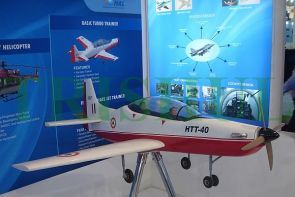An IAF "request for information" floated on the MoD website invites Indian companies to submit preliminary bids to supply the IAF with 106 PC-7 Mk II trainers. Ajai Shukla reports
 The Indian Air Force continues its quest to hand Pilatus Aircraft Ltd of Switzerland a Rs 6,000 contract for 106 PC-7 Mark II basic trainer aircraft, over and above the 75 Pilatus trainers already bought for Rs 3,850 crore (Swiss Franc 557 million).
The Indian Air Force continues its quest to hand Pilatus Aircraft Ltd of Switzerland a Rs 6,000 contract for 106 PC-7 Mark II basic trainer aircraft, over and above the 75 Pilatus trainers already bought for Rs 3,850 crore (Swiss Franc 557 million).
Hindustan Aeronautics Ltd is currently developing these 106 trainers in India, a project the IAF is sparing no effort to scuttle.
A new IAF "Request for Information" -- a pre-tender enquiry -- floated on the ministry of defence website invites Indian companies to submit preliminary bids to supply the IAF with 106 PC-7 Mk II trainers, in partnership with Pilatus. This envisages the import of an unspecified number of BTAs ready built, with the remainder being assembled in India. In MoD's procurement rule book, this is termed a "Buy & Make (Indian)" acquisition.
In floating this RFI, the IAF has openly defied the MoD. In 2009, while giving nod to the acquisition of 181 trainers, Defence Minister A K Antony ruled that 106 trainers would be built in HAL under the "Make" category, while 75 would be imported.
Since then, the IAF has repeatedly sought to subvert this decision. The MoD has confirmed to Business Standard that the 2009 decision to build 106 trainers in HAL, which was taken by the apex Defence Acquisition Council, remains valid.
"This RFI is a preliminary inquiry that the IAF has sent out, presumably to enlighten itself. This doesn't mean that an RfP (Request for Proposal, as a defence tender is called) will be issued," said the MoD spokesperson.
The IAF has consistently resisted HAL's indigenous trainer -- the Hindustan Turbo Trainer-40 (HTT-40). As Business Standard reported (July 29, 2013, "Indian Air Force at war with Hindustan Aeronautics; wants to import, not build, a trainer") former IAF boss, Air Chief Marshal N A K Browne, wrote personally to Antony, claiming that the HTT-40 would be costlier than the PC-7 Mk II. A cost analysis by Business Standard, however, suggested the HAL trainer would be much cheaper over its service life. The MoD did not accept the air chief's request.
The IAF next asked HAL to scuttle its own BTA project and instead build the PC-7 Mk II trainer in Bangalore with Pilatus technology (October 14, 2013, "IAF to HAL: Build Swiss trainer aircraft, don't develop your own"). HAL, which has worked steadily on the HTT-40, flatly rejected this proposition.
Bizarrely, Air Chief Marshal Browne next suggested that the PC-7 Mk II be built in an IAF base repair depots. Admitting that BRDs were meant only to maintain and overhaul aircraft and engines, he claimed last October that they could also assemble aircraft. The MoD simply ignored this suggestion, which was hastily rebutted by the IAF's maintenance chief, Air Marshal P Kanakaraj.
Now, with Air Chief Marshal Browne having retired and been cleared by the government to be an ambassador, reportedly to Finland, his successor, Air Chief Marshal Arup Raha, has proposed that Indian private companies build the PC-7 Mk II with Pilatus technology.
Industry experts say there is little in this proposal for private Indian companies. With each BTA priced at about Rs 35 crore, the 10 per cent profit margin from building 106 aircraft would be barely Rs 370 crore. This is a small compensation for the costs and risks of a company's first foray into aerospace manufacture.
Meanwhile, HAL continues work on the HTT-40. With MoD funding blocked by the IAF, HAL has already committed Rs 137 crore of its own money; and stands ready to allocate another Rs 200 crore. On a recent visit to HAL, Business Standard was briefed that the design of structural components is done; assembly drawings will be done by April. A first flight is targeted for early 2015.
"We had planned to build one flying prototype of the HTT-40 and one ground test specimen. Now, to speed up design and flight testing, HAL will build three flying prototypes and two ground test models," says Prashantsingh Bhadoria, one of HAL's talented young designers who is deputy head of the HTT-40 project.
HAL designers are confident that, given their major role in developing the Tejas fighter; and the Sitara intermediate jet trainer that is nearly complete, there is little doubt that the company will build a successful basic trainer.
IAF planners know that the procurement cost of an aircraft is just one-fifth to one-tenth of the cost of operating it through its service life. For that reason, an indigenous aircraft is significantly cheaper in the long term than an overseas purchase, where the IAF remains dependent for spares, overhauls and upgrades on foreign vendors who invariably jack up prices after the initial sale. HAL designers say they are ensuring a high degree of commonality in parts and sub-systems between the HTT-40 and the IJT. This will reduce production costs and also ease inventory problems in training establishments.
IAF pilots need three types of trainer aircraft. In Stage-1 training, rookie pilots learn basic flying on aircraft like the PC-7 Mk I, and the HTT-40. Stage-2 training involves more complex flying on aircraft like the Kiran Mark 1, or the Sitara IJT. Stage-3 training, which prepares pilots for occupying the cockpits of frontline IAF fighters, is done on Hawk advanced jet trainers, which are built in HAL.
Image: HAL's indigenous trainer -- the Hindustan Turbo Trainer-40
For our defence coverage click here








